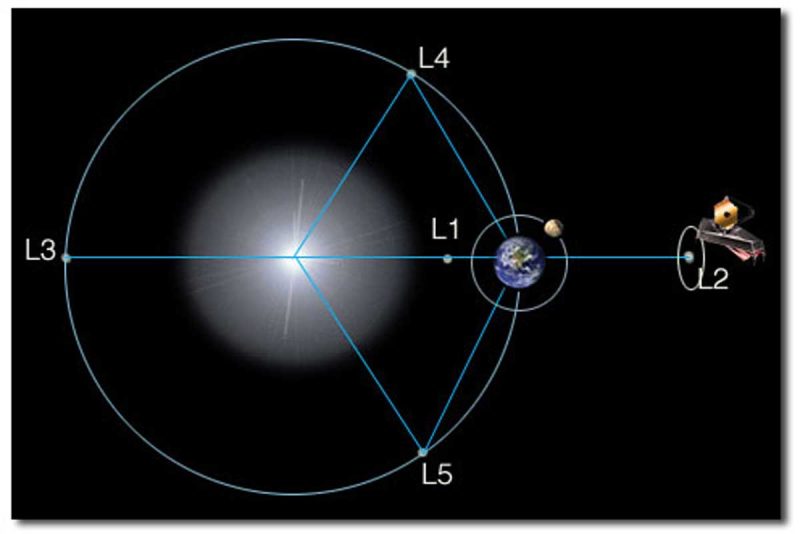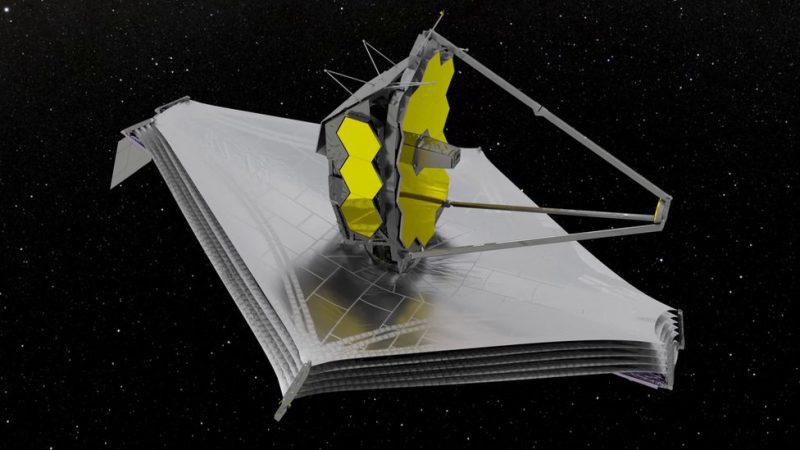
The James Webb Space Telescope’s dramatic unfolding is now complete. On Wednesday (January 19, 2022), engineers finished deploying the individual mirror segments. On Monday, ground teams plan to fire Webb’s thrusters, placing the telescope at its final destination, Lagrange point 2, or L2, some million miles (1.5 million km) away from Earth. NASA TV is scheduled to begin its coverage at mission control at 19 UTC (2 p.m. Eastern) on Monday. There’s also going to be a live event, where experts will be answering questions. That’ll begin at 20 UTC (3 p.m. Eastern) Monday.
The 2 p.m. Eastern broadcast will air live on NASA TV.
The 3 p.m. Eastern live online panel discussion will air on the NASA Science Live website, as well as YouTube, Facebook, and Twitter. Audio of the teleconference will stream live on the agency’s website.
Before this past month, space fans were jokingly referring to the month between Webb’s December 25 launch – and its January 24 placement at L2 – as 30 days of terror. That’s because, overall, Webb has 344 single-point failure items. About 80% of those items followed launch and were part of the deployment process. But wow! Things have gone smoothly so far. Webb’s engineers must be secretly breathing sighs of relief and feeling very proud! As they should. Webb is a marvelous machine.
Once Webb is safely at L2, the team will work on telescope alignment, with first images from the telescope due to arrive this summer.
EarthSky lunar calendars are back in stock! We’re guaranteed to sell out – get one while you can.
We're gearing up to insert #NASAWebb into its orbit!
What to expect on Jan. 24:
? 3pm ET (20:00 UTC) NASA Science Live: Ask questions with #UnfoldTheUniverse ?
? 4pm ET (21:00 UTC) Media teleconference with @NASAGoddard & @northropgrumman expertshttps://t.co/6MhQ60Mxzz pic.twitter.com/ReB8umJQLB— NASA Webb Telescope (@NASAWebb) January 20, 2022
Why L2, and where is it?
So, why is Webb going to a point so far away? Basically, this point in space – the second Lagrangian point – is where, in the Earth-sun system, gravitational forces and a body’s orbital motion balance each other. So, in effect, a spacecraft can “hover” relatively easily at L2. It can stay near Earth, while both Earth and the spacecraft orbit the sun. In fact, the European Space Agency (ESA) has called L2:
… a preeminent location for advanced space probes.
Other notable space observatories orbit, or will orbit, the sun at L2, including ESA’s redoubtable Gaia spacecraft, which has made so many fascinating discoveries about our Milky Way galaxy. And Gaia and Webb aren’t the only spacecraft at L2. Click here for a list of past, present and planned space probes at L2.
Keeping Webb safe from the heat
L2 has another advantage. It’s a step farther away from the heat of the sun and Earth. Satellites in Earth orbit – for example Hubble and the space station – undergo temperature changes about every 90 minutes, depending on whether the satellite is in shadow or sun. At L2, Webb won’t undergo this same temperature-shifting effect that would otherwise create distortions in the telescope’s ability to view the universe.
Webb will observe primarily infrared light coming from faint and very distant objects. To be able to detect those faint signals, the telescope itself must be kept extremely cold: -370 F (about -220 C) or lower. That’s why Webb has a five-layer, tennis-court-sized sunshield, to protect the telescope from the heat of the sun and keep its instruments cold.
Being at L2, farther from the sun than the Earth or moon, will help, too.
Webb’s unfolding, step by step
Webb successfully launched on an Ariane 5 rocket on December 25, 2021. Next, it successfully deployed its solar array to stop draining battery power. It then successfully completed two mid-course correction burns. Then, Webb released its antenna. It lowered the forward and aft pallet structures that support the sunshield. On January 4, it completed the deployment and tensioning of all five layers of the sunshield.
On January 5, 2022, Webb’s team deployed the secondary mirror, the step that gave mission scientist Heidi Hammel the most trepidation. She’d been quoted earlier as saying:
For me, personally, that’s the scariest part of the whole deployment sequence, the secondary mirror … If we don’t have a secondary mirror, we don’t get any light from space into our cameras and spectrographs. There’s nothing.
On January 7, Webb unfolded the first of two primary mirror “wings.” On January 8, it unfolded the second mirror “wing,” concluding major deployments. Webb’s primary mirror is six times larger than Hubble’s. It’s made of 18 individual mirror segments, which were folded for launch. Now that they’ve been successfully deployed – and after Webb is safe at L2 – those 18 segments will all need to be recalibrated (aligned), which will take about 10 days.
Ten days of mirror alignment, followed by weeks of testing, are the reasons the telescope won’t be ready for scientific operations for about six months.

Earlier NASA Webb Telescope tweet updates
On Twitter, NASA has been providing near real-time updates when Webb successfully completes steps of its mission. You can follow along what’s going on with the telescope, too, at NASA Webb Telescope.
#NASAWebb is fully deployed! ?
With the successful deployment & latching of our last mirror wing, that's:
50 major deployments, complete.
178 pins, released.
20+ years of work, realized.Next to #UnfoldTheUniverse: traveling out to our orbital destination of Lagrange point 2! pic.twitter.com/mDfmlaszzV
— NASA Webb Telescope (@NASAWebb) January 8, 2022
Nope, we’re not just winging it! But we did successfully deploy and latch the first of our two primary mirror wings. ?
These side panels, folded back for launch, each hold 3 of Webb’s 18 mirror segments. Next up: our final wing! https://t.co/xnaWZXYiSx #UnfoldTheUniverse pic.twitter.com/mBQ0S7eB2w
— NASA Webb Telescope (@NASAWebb) January 7, 2022
Space telescope radiators: they’re instrumental!
Our “trap door” is now open: the ADIR (Aft Deployable Instrument Radiator) has swung out from the back of the telescope to radiate heat from our science instruments into space. https://t.co/os8QVTpzN3 #UnfoldTheUniverse pic.twitter.com/kwAhvGoRAw
— NASA Webb Telescope (@NASAWebb) January 6, 2022
? Secondary mirror deployed! But there's little time to pause and reflect.
Teams will ensure @NASAWebb's tripod structure is latched before beginning its final major milestone this week: full deployment of the space telescope's honeycomb-shaped primary mirror. pic.twitter.com/dT9kv5oDqS
— NASA Webb Telescope (@NASAWebb) January 5, 2022
This is it: we’ve just wrapped up one of the most challenging steps of our journey to #UnfoldTheUniverse.
With all five layers of sunshield tensioning complete, about 75% of our 344 single-point failures have been retired! pic.twitter.com/P9jJhu7bJX
— NASA Webb Telescope (@NASAWebb) January 4, 2022
Shine bright like a diamond ?
With the successful deployment of our right sunshield mid-boom, or “arm,” Webb’s sunshield has now taken on its diamond shape in space. Next up: tensioning the 5 sunshield layers! https://t.co/6G2caS1djY #UnfoldTheUniverse pic.twitter.com/q0iuHdnKlN
— NASA Webb Telescope (@NASAWebb) January 1, 2022
Find it hard to get out from under the covers in the morning? Imagine doing it in space!
Our sunshield covers protected the sunshield while it was folded for launch. Today those covers were removed to prep for unfolding the sunshield! https://t.co/QRU4ljKelz #UnfoldTheUniverse pic.twitter.com/t3DbSxpIH9
— NASA Webb Telescope (@NASAWebb) December 30, 2021
We just successfully deployed our aft (back) momentum flap, which helps balance pressure from solar radiation on Webb's sunshield, much like a trim tab helps stabilize a boat or plane! ? ??
Sail on, Webb! https://t.co/mY5CEFzm3T #UnfoldTheUniverse pic.twitter.com/CVAzB6wFhP
— NASA Webb Telescope (@NASAWebb) December 30, 2021
Moving on up! ??
Our team has just confirmed that we have successfully extended our Deployable Tower Assembly (DTA) upwards, making space for our sunshield deployments in the next few days — another step completed as we #UnfoldTheUniverse: https://t.co/oJcYs13Ju3 pic.twitter.com/eaaHpC5GxS
— NASA Webb Telescope (@NASAWebb) December 29, 2021
? And we just confirmed that our aft (back) sunshield pallet has successfully opened up as well! https://t.co/la05MOFIIE
What’s next to #UnfoldTheUniverse? Check out https://t.co/NXe96U821e pic.twitter.com/F0B9Z1lUiQ
— NASA Webb Telescope (@NASAWebb) December 29, 2021
It’s been a busy evening! Not only did we just complete our second burn, but #NASAWebb also passed the altitude of the Moon as it keeps cruising on to the second Lagrange point to #UnfoldTheUniverse. Bye, @NASAMoon! ? ? pic.twitter.com/IStul0fwFB
— NASA Webb Telescope (@NASAWebb) December 28, 2021
Burn, baby, burn! No, we didn't have a disco inferno — we just completed our second mid-course correction burn as we continue to fine-tune #NASAWebb's trajectory to Lagrange point 2. This burn is one of three planned course corrections: https://t.co/bQpwxNp7r8#UnfoldTheUniverse pic.twitter.com/v5kOgQv90n
— NASA Webb Telescope (@NASAWebb) December 28, 2021
? Hello Webb? It's us, Earth!
Our team just deployed the gimbaled antenna assembly, which includes Webb’s high-data-rate dish antenna. This antenna will be used to send at least 28.6 Gbytes of data down from the observatory, twice a day: https://t.co/4vKcbjbKJO pic.twitter.com/zFjhF3yLzY
— NASA Webb Telescope (@NASAWebb) December 26, 2021
Success! #NASAWebb’s first mid-course correction burn helped fine-tune Webb's trajectory toward its orbit around the second Lagrange point, a million miles (1.5 million km) from Earth: https://t.co/fCx9tOm7ZI#UnfoldTheUniverse pic.twitter.com/1fb7EGbzE9
— NASA Webb Telescope (@NASAWebb) December 26, 2021
#NASAWebb is safely in space with its solar array drawing power from the Sun! Its reaction wheels will keep the spacecraft pointed in the right direction so that its sunshield can protect the telescope from radiation and heat: https://t.co/NZJ7sSJ8fX#UnfoldTheUniverse pic.twitter.com/s4nfqvKJZD
— NASA Webb Telescope (@NASAWebb) December 25, 2021
Webb vs. Hubble
Hubble provided images in visible light. But Webb is an infrared telescope. The advantage of infrared is that Webb will be able to look farther into the universe than ever before. NASA gave a great visualization of the power of Webb to look into the past during a Q&A session on Reddit:
Imagine all of time, from the beginning of the universe until now, is represented on a year-long calendar. If right now is December 31 at 11:55 pm, Webb will be able to see all the way back to January 6th.
NASA also explained why scientists want to see in the infrared and use spectroscopy. Spectroscopy allows astronomers to:
understand what is there, not just how it looks.
Looking deeper
When a Reddit user asked if Webb was going to reproduce the famous Hubble Ultra Deep Field photo, NASA said:
Webb will observe the Ultra Deep Field in our first year of science operations. It’ll take Webb less than a day to see deeper than Hubble saw in two weeks of staring. Webb is going to go much deeper, finding tens of thousand of galaxies that are too red and too faint for Hubble to detect.
Of course, we’ve all been wowed and moved for decades by what the Hubble Space Telescope has shown us of the universe. Now, we expect to be further blown away by the images and revelations of Hubble’s successor, the James Webb Space Telescope.

Bottom line: The James Webb Space Telescope has been unfolding its major components on its way to L2. After it’s safely in orbit, the telescope will undergo alignment in preparation for its science mission.











